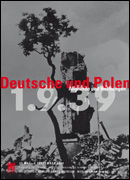


Exhibition | Oppression and Self-assertion | War and Occupation | Conflicts and Rapprochements
The Invasion
| Forced Labor
| Colonization, Deportation, Extermination
Genocide
| Resistance and Self-assertion
The End of the War
| Expulsion of the Germans
| Expulsion of the Poles
As was the case in 1939, the end of the war and the period immediately following it witnessed massive movements of refugees from one country to another in Eastern and Southeastern Europe, involving both Germans and Poles, as well as many other nations.
The population of Germany's eastern provinces fled in the face of the Red Army's advance in the winter of 1944/45. After the war, parts of East Prussia and Brandenburg, as well as Silesia and Pomerania, were placed under Polish administrative control and in the first wave of expulsions, in June and July of 1945, many Germans were forced to leave their cities and villages, which would henceforth be part of Poland.
At the Potsdam Conference, the Allies agreed on an "orderly transfer of German populations" from the areas east of the Oder and Neisse Rivers, and Poland implemented this resolution in the years which followed. All together, over eight million Germans were forced to leave their homes, including five million refugees who had fled the area and were not allowed to return. Flight and expulsion cost the lives of many hundreds of thousands of people.
